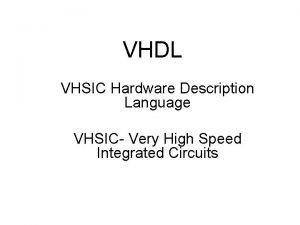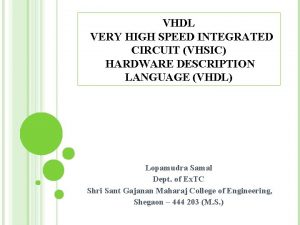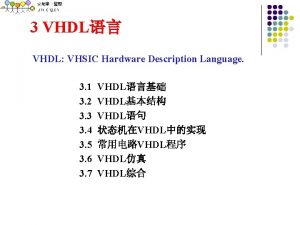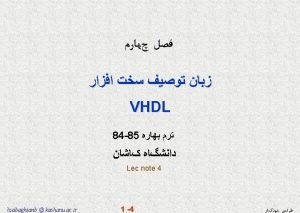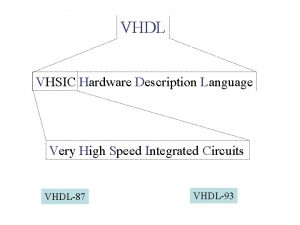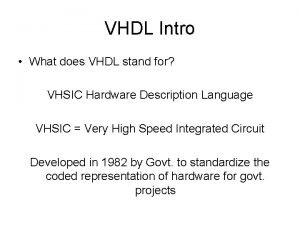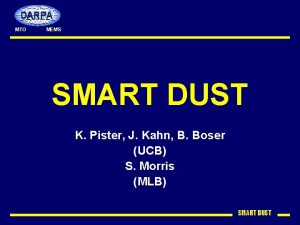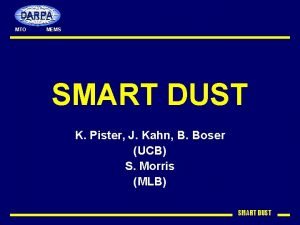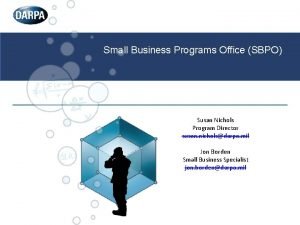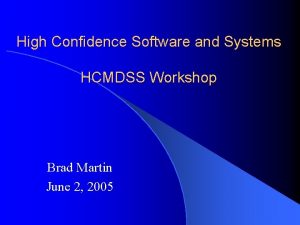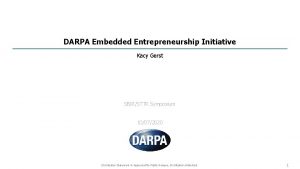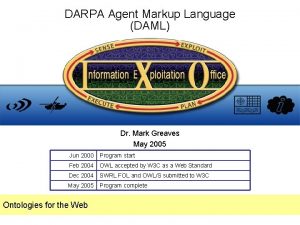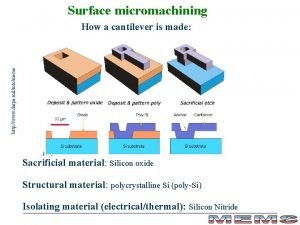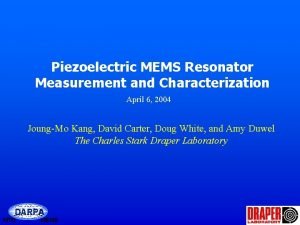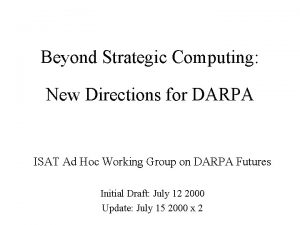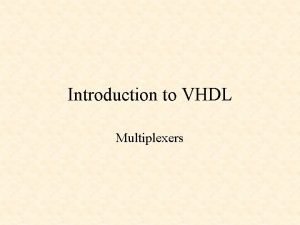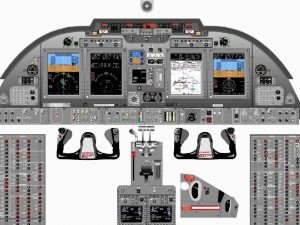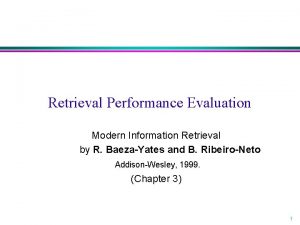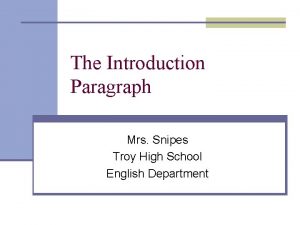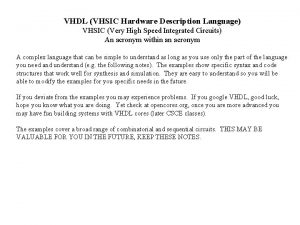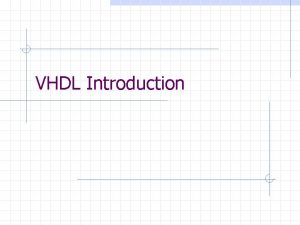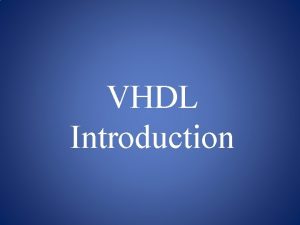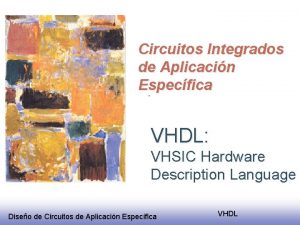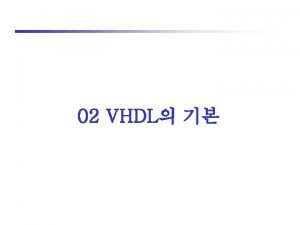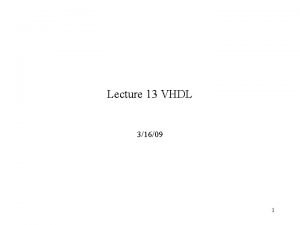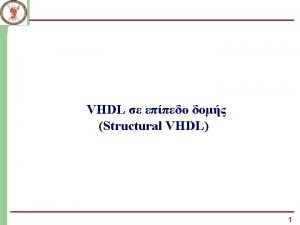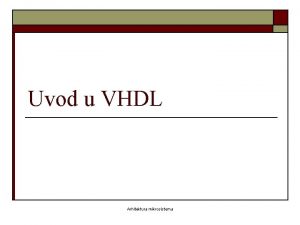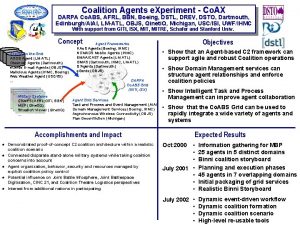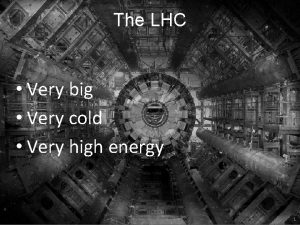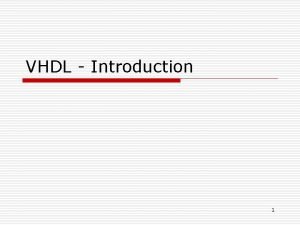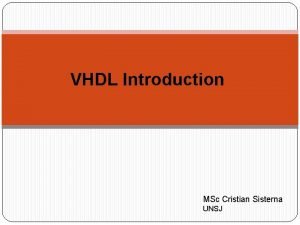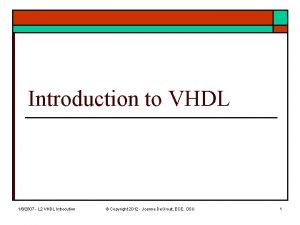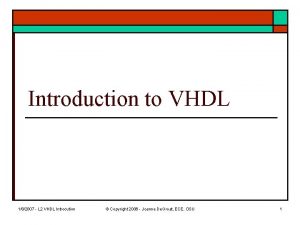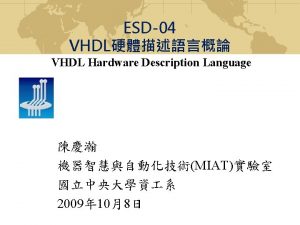Introduction to VHDL VHDL DARPA VHSIC Very High























![Subtypes • subtype identifier is type_mark [ range expr. (to | downto) expr. ] Subtypes • subtype identifier is type_mark [ range expr. (to | downto) expr. ]](https://slidetodoc.com/presentation_image_h2/ec0e53cb56814f92b8a368483e76cf05/image-24.jpg)













![Array aggregates aggregate <= (([choices => ] expr. ) {, …}) choices <= (expr. Array aggregates aggregate <= (([choices => ] expr. ) {, …}) choices <= (expr.](https://slidetodoc.com/presentation_image_h2/ec0e53cb56814f92b8a368483e76cf05/image-38.jpg)






- Slides: 44

Introduction to VHDL

VHDL • DARPA, VHSIC (Very High Speed Integrated Circuits) program • Different manufacturers • Standard language to describe – Structure – Function • VHDL (VHSIC Hardware Description Language) • Based on ADA

VHDL • Requirements – Describe structure – Specification – Simulation – Synthesis • 1987, IEEE Standard 1076, VHDL-87 • Revisions: – 1992 -1993, VHDL-93 – 1998 -2001, VHDL-2001

Domains and Levels of Modeling

VHDL Modeling Concepts entity reg 4 is port ( d 0, d 1, d 2, d 3, en, clk : in bit; q 0, q 1, q 2, q 3 : out bit ); end reg 4;

Behavioral Model architecture behav of reg 4 is begin storage : process is variable stored_d 0, stored_d 1, stored_d 2, stored_d 3 : bit; begin if en = '1' and clk = '1' then stored_d 0 : = d 0; stored_d 1 : = d 1; stored_d 2 : = d 2; stored_d 3 : = d 3; end if; q 0 <= stored_d 0 after 5 ns; q 1 <= stored_d 1 after 5 ns; q 2 <= stored_d 2 after 5 ns; q 3 <= stored_d 3 after 5 ns; wait on d 0, d 1, d 2, d 3, en, clk; end process storage; end architecture behav;

Structural Model

Structural Model entity d_latch is port ( d, clk : in bit; q : out bit ); end d_latch; architecture basic of d_latch is begin latch_behavior : process is begin if clk = '1' then q <= d after 2 ns; end if; wait on clk, d; end process latch_behavior; end architecture basic; entity and 2 is port ( a, b : in bit; y : out bit ); end and 2; architecture basic of and 2 is begin and 2_behavior : process is begin y <= a and b after 2 ns; wait on a, b; end process and 2_behavior; end architecture basic;

Structural Model architecture struct of reg 4 is signal int_clk : bit; begin bit 0 : entity work. d_latch(basic) port map (d 0, int_clk, q 0); bit 1 : entity work. d_latch(basic) port map (d 1, int_clk, q 1); bit 2 : entity work. d_latch(basic) port map (d 2, int_clk, q 2); bit 3 : entity work. d_latch(basic) port map (d 3, int_clk, q 3); gate : entity work. and 2(basic) port map (en, clk, int_clk); end architecture struct;

Test Benches

Test Benches entity test_bench is end entity test_bench; architecture test_reg 4 of test_bench is signal d 0, d 1, d 2, d 3, en, clk, q 0, q 1, q 2, q 3 : bit; begin dut : entity work. reg 4(behav) port map ( d 0, d 1, d 2, d 3, en, clk, q 0, q 1, q 2, q 3 ); stimulus : process is begin d 0 <= '1'; d 1 <= '1'; d 2 <= '1'; d 3 <= '1'; en <= '0'; clk <= '0'; wait for 20 ns; en <= '1'; wait for 20 ns; clk <= '1'; wait for 20 ns; d 0 <= '0'; d 1 <= '0'; d 2 <= '0'; d 3 <= '0'; wait for 20 ns; en <= '0'; wait for 20 ns; --. . . wait; end process stimulus; end architecture test_reg 4;

Lexical elements • Comment variable data : bit; --description of variable data --this is a long. . . --. . . long comment • Identifiers – – ‘A’ to ‘Z’, ‘a’ to ‘z’, ‘ 0’ to ‘ 9’ and ‘_’ Must start with an alphabetic letter No successive underlines, not end with underline Case insensitive: Cat, CAT, cat, Ca. T are the same

Reserved words abs configuration impure null rem type access constant in of report unaffected after disconnect inertial on return units alias downto inout open rol until all else is or ror use and elsif label others select variable architecture end library out severity wait array entity linkage package signal when assert exit literal port shared while attribute file loop postponed sla with begin for map procedure sll xnor block function mod process sra Xor body generate nand pure srl buffer generic new range subtype bus group next record Then case guarded nor register to component if not reject transport

Numbers • Decimal literals – 23, 0, 146 • Real literals – 23. 1, 0. 0, 3. 14159 – 46 E 5, 1 E+12, 34. 0 e-08 • Number base – 2#111111011#, 16#FD#, 16#0 fd#, 8#0375# – 2#0. 1000#, 8#0. 4#, 12#0. 6# • 123_456, 3. 141_592_6, 2#1111_1100#

Characters, strings, bit strings • Characters – ‘A’, ‘z’, ‘, ’, ‘’’, ‘ ‘ • Strings – ”A string”, ”” --empty string • Bit strings – Binary, B” 0110001”, b” 0110_0111” – Octal, O” 372”, o” 00” – Hex, X”FA”, x” 0 d”

Constant and Variable declaration constant identifier {, . . . }: subtype_indication [: = expression]; variable identifier {, . . . }: subtype_indication [: = expression]; constant constant number_of_bytes : integer : = 4; number_of_bits : integer : = 8* number_of_bytes; e : real : = 2. 71828; prop_delay : time : = 3 ns; size_limit, count_limit : integer : = 255; variable index : integer : = 0; variable sum, average, largest : real; variable start, finish : time : = 0 ns;

Type declarations • type identifier is type_definition • Integer types type_definition <= range expr. (to | downto) expr. type apples is range 0 to 100; type oranges is range 0 to 100; oranges: =apples; --illegal!!! constant number_of_bits : integer : =32; type bit_index is range 0 to number_of_bits-1;

Floating-point types type_definition <= range expr. (to | downto) expr. type input_level is range -10. 0 to +10. 0; type probability is range 0. 0 to 1. 0;

Physical types range expr. (to | downto) expr. units identifier; {identifier = physical_literal; } end units [identifier]; physical_literal <= [decimal_literal | based_literal] unit_name

Physical types type resistance is range 0 to 1 E 9 units ohm; end units resistance; type length is range 0 to 1 E 9 units um; --primary unit micron mm=1000 um; --metric units m=1000 mm; inch=25400 um; --English units foot=12 inch; end units length;

Physical types type time is range impl. def. units fs; ps=1000 fs; ns=1000 ps; us=1000 ns; ms=1000 us; sec=1000 ms; min=60 sec; hr=60 min; end units;

Enumeration types type alu_function is (disable, pass, add, subtract, multiply, divide); type octal_digit is (’ 0’, ’ 1’, ’ 2’, ’ 3’, ’ 4’, ’ 5’, ’ 6’, ’ 7’); variable alu_op : alu_function; variable last_digit : octal_digit : = ’ 0’; alu_op: =subtract; last_digit: =’ 7’; type boolean is (false, true);

Bits, Standard logic • Bits type bit is (’ 0’, ’ 1’); • Standard logic type std_ulogic is ( ’U’, --Uninitialized ’X’, --Forcing unknown ’ 0’, --Forcing 0 ’ 1’, --Forcing 1 ’Z’, --High impedance ’W’, --Weak unknown ’L’, --Weak 0 ’H’, --Weak 1 ’-’, --Don’t care );
![Subtypes subtype identifier is typemark range expr to downto expr Subtypes • subtype identifier is type_mark [ range expr. (to | downto) expr. ]](https://slidetodoc.com/presentation_image_h2/ec0e53cb56814f92b8a368483e76cf05/image-24.jpg)
Subtypes • subtype identifier is type_mark [ range expr. (to | downto) expr. ] • Predefinied subtypes – subtype natural is integer range 0 to highest_integer; – subtype positive is integer range 1 to highest_integer;

Type qualification type logic_level is (unknown, low, undriven, high); type system_state is (unknown, ready, busy); subtype valid_level is logic_level range low to high; logic_level’(unknown), system_state ’(unknown) logic_level’(high), valid_level’(high)

Type Conversion • real(123) • integer(1. 23)

Attributes T’left T’right T’low T’high T’ascending T’image(x) x T’value(s) by s -- first (leftmost) value in T -- last (rightmost) value in T -- least value in T -- greatest value in T -- true if T is an ascending range -- a string representing the value of -- the value in T that is represented

Attributes type set_index_range is range 21 downto 11; set_index_range’left= 21 set_index_range’right= 11 set_index_range’low= 11 set_index_range’high= 21 set_index_range’ascending= false set_index_range’image(14)= ” 14” set_index_range’value(” 20”)= 20

Attributes type logic_level is (unknown, low, undriven, high); logic_level’left= unknown logic_level’right= high logic_level’low= unknown logic_level’high= high logic_level’ascending= true logic_level’image(undriven)= ”undriven” logic_level’value(”LOW”)= low

Attributes for discrete and physical types T’pos(x) T’val(n) T’succ(x) T’pred(x) T’leftof(x) T’rightof(x) -- position number of x in T -- value in T at position x -- value in T at position one greater than that of x -- value in T at position one less than that of x -- value in T at position one to the left of x -- value in T at position one to the right of x

Attributes type logic_level is (unknown, low, undriven, high); logic_level’pos(unknown)= 0 logic_level’val(3)= high logic_level’succ(unknown)= low logic_level’pred(undriven)= low logic_level’ascending= true logic_level’image(undriven)= ”undriven” logic_level’value(”LOW”)= low time’pos(4 ns)=4_000

Expressions and operators ** abs not * / mod rem + + & sll srl sla exponentation absolute value negation multiplication division modulo remainder identity negation addition subtraction concatenation shift-left logical shift-right logical shift-left arithmetic sra rol ror = /= < <= > >= and or nand nor xnor shift-right arithmetic rotate left rotate right equality inequality less than or equal greater than or equal logical and logical or negated logical and negated logical or exclusive or negated exclusive or

Arrays • array (discrete_range {, …}) of element_subtype_indication • discrete_range <= discrete_subtype_indication | expr. ( to | downto) expr. • subtype_indication <= type_mark [range expr. (to | downto) expr. ] • type word is array (0 to 31) of bit • type word is array (31 downto 0) of bit;

Arrays type word is array (0 to 31) of bit subtype coeff_ram_address is integer range 0 to 63; type coeff_array is array (coeff_ram_address) of real; variable buffer_register, data_register : word; variable coeff : coeff_array; coeff(0): =0. 0; data_register: =buffer_register;

Arrays type controller_state is (initial, idle, active, error); type state_counts is array (idle to error) of natural; type state_counts is array (controller_state range idle to error) of natural; variable counters : state_counts; counters(active): =counters(active)+1;

Multidimensional arrays type symbol is (’a’, ’t’, ’d’, ’h’, digit, cr, error); type state is range 0 to 6; type transition_matrix is array (state, symbol) of state; variable transition_table : transition_matrix; transition_table(5, ’d’);

Multidimensional arrays constant next_state : transition_matrix : = ( 0 => ('a' => 1, others => 6), 1 => ('t' => 2, others => 6), 2 => ('d' => 3, 'h' => 5, others => 6), 3 => (digit => 4, others => 6), 4 => (digit => 4, cr => 0, others => 6), 5 => (cr => 0, others => 6), 6 => (cr => 0, others => 6) );
![Array aggregates aggregate choices expr choices expr Array aggregates aggregate <= (([choices => ] expr. ) {, …}) choices <= (expr.](https://slidetodoc.com/presentation_image_h2/ec0e53cb56814f92b8a368483e76cf05/image-38.jpg)
Array aggregates aggregate <= (([choices => ] expr. ) {, …}) choices <= (expr. | discrete_range | others) {| …} type coeff_array is array (coeff_ram_address) of real; variable coeff: coeff_array: =(0=>16, 1=>2. 3, 2=>1. 6, 3 to 63=>0. 0); variable coeff: coeff_array: =(0=>16, 1=>2. 3, 2=>1. 6, others=>0. 0); variable coeff: coeff_array: =(0|2=>16, 1=>2. 3, others=>0. 0);

Array attributes A’left(N) -- left bound of index range A’right(N) -- right bound of index range A’low(N) -- lower bound of index range A’high(N) -- upper bound of index range A’range(N) -- index range of dim. N of A A’reverse_range(N)-- reverse of index range A’length(N) -- length of index range A’ascending(N) -- true if index range is ascending

Array attributes type A is array (1 to 4, 31 downto 0) of boolean; A'left(1)=1 A'low(1)=1 A'right(2)=0 A'high(2)=31 A'length(1)=4 A'length(2)=32 A'ascending(1)=true A'ascending(2)=false A'low=1 A'length=4

Unconstrained Array Types type sample is array (natural range <>) of integer; variable short_sample_buf : sample(0 to 63); type string is array (positive range <>) of character; type bit_vector is array (natural range <>) of bit; subtype byte is bit_vector(7 downto 0); type std_ulogic_vector is array (natural range <> ) of std_ulogic; subtype std_ulogic_word is std_ulogic_vector(0 to 31); signal csr_offset : std_ulogic_vector(2 downto 1); variable current_test : std_ulogic_vector(0 to 13) : = "ZZZZZ----"; constant all_ones : std_ulogic_vector(15 downto 0) : = X"FFFF";

Array Slices entity byte_swap is port (input : in halfword; output : out halfword); end entity byte_swap; ---------------------architecture behavior of byte_swap is begin swap : process (input) begin output(8 to 15) <= input(0 to 7); output(0 to 7) <= input(8 to 15); end process swap; end architecture behavior;

Records type time_stamp is record seconds : integer range 0 to 59; minutes : integer range 0 to 59; hours : integer range 0 to 23; end record time_stamp; variable sample_time, current_time : time_stamp; sample_time: =current_time; sample_hour: =sample_time. hours; constant midday : time_stamp: =(0, 0, 12); constant midday : time_stamp : = (hours => 12, minutes => 0, seconds => 0);

Next time • • Modelsim VHDL simulator Xilinx Foundation ISE Digilent Nexys-II development board VHDL Sequential Statements
 Vhsic hardware description language
Vhsic hardware description language Very high speed integrated circuit
Very high speed integrated circuit Language
Language Vhsic hdl
Vhsic hdl Vhsic hardware description language
Vhsic hardware description language Vhsic stands for
Vhsic stands for Darpa
Darpa Darpa budget
Darpa budget Smart dust darpa
Smart dust darpa Darpa ember
Darpa ember Darpa smart dust
Darpa smart dust Wes bennett darpa
Wes bennett darpa Darpa
Darpa Darpa vulture
Darpa vulture Darpa small business programs office (sbpo)
Darpa small business programs office (sbpo) Brad martin darpa
Brad martin darpa Darpa embedded entrepreneur initiative
Darpa embedded entrepreneur initiative Darpa agent markup language
Darpa agent markup language Darpa project nimbus
Darpa project nimbus Darpa agent markup language
Darpa agent markup language Darpa blackjack
Darpa blackjack Darpa
Darpa Darpa mto
Darpa mto Amy duwel
Amy duwel 台大tcp
台大tcp New directions in computing
New directions in computing Figure 10
Figure 10 Multiplication of scientific notation
Multiplication of scientific notation Very little or very few
Very little or very few Receiving table/area
Receiving table/area Food quantifiers exercise
Food quantifiers exercise Introduction to vhdl
Introduction to vhdl Low mass star life cycle
Low mass star life cycle Which rock possesses very high compressive strength
Which rock possesses very high compressive strength Vor reference and variable phase
Vor reference and variable phase High precision vs high recall
High precision vs high recall High precision vs high recall
High precision vs high recall Supportive behavior
Supportive behavior High expectations high support
High expectations high support High precision vs high accuracy
High precision vs high accuracy Directive behavior and supportive behavior
Directive behavior and supportive behavior High risk high return artinya
High risk high return artinya High school introduction paragraph
High school introduction paragraph Voltage level
Voltage level Introduction to high density interconnects
Introduction to high density interconnects
